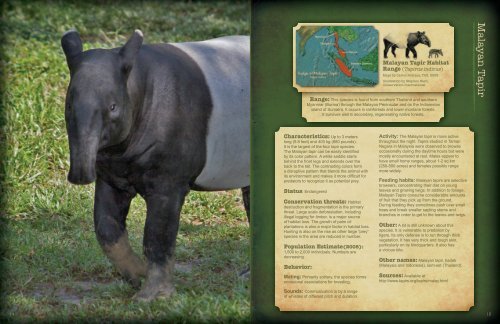About Tapirs - Tapir Specialist Group
About Tapirs - Tapir Specialist Group
About Tapirs - Tapir Specialist Group
Create successful ePaper yourself
Turn your PDF publications into a flip-book with our unique Google optimized e-Paper software.
Malayan <strong>Tapir</strong> Habitat<br />
Range (<strong>Tapir</strong>us indicus)<br />
Maps by Carlos Pedraza, TSG, 2008<br />
Illustration by Stephen Nash,<br />
Conservation International<br />
Range: This species is found from southern Thailand and southern<br />
Myanmar (Burma) through the Malayan Peninsular and on the Indonesian<br />
island of Sumatra. It occurs in rainforests and lower montane forests.<br />
It survives well in secondary, regenerating native forests.<br />
Characteristics: Up to 3 meters<br />
long (9.8 feet) and 400 kg (880 pounds).<br />
It is the largest of the four tapir species.<br />
The Malayan tapir can be easily identified<br />
by its color pattern. A white saddle starts<br />
behind the front legs and extends over the<br />
back to the tail. The contrasting colors form<br />
a disruptive pattern that blends the animal with<br />
its environment and makes it more difficult for<br />
predators to recognize it as potential prey.<br />
Status: Endangered<br />
Conservation threats: Habitat<br />
destruction and fragmentation is the primary<br />
threat. Large scale deforestation, including<br />
illegal logging for timber, is a major source<br />
of habitat loss. The growth of palm oil<br />
plantations is also a major factor in habitat loss.<br />
Hunting is also on the rise as other large “prey”<br />
species in the area are reduced in number.<br />
Population Estimate(2008):<br />
1,500 to 2,000 individuals. Numbers are<br />
decreasing.<br />
Behavior:<br />
Mating: Primarily solitary, the species forms<br />
occasional associations for breeding.<br />
Sounds: Communication is by a range<br />
of whistles of different pitch and duration.<br />
Activity: The Malayan tapir is more active<br />
throughout the night. <strong><strong>Tapir</strong>s</strong> studied in Taman<br />
Negara in Malaysia were observed to browse<br />
occasionally during the daytime hours but were<br />
mostly encountered at rest. Males appear to<br />
have small home ranges, about 1-2 sq km<br />
(250-500 acres) and females possibly range<br />
more widely.<br />
Feeding habits: Malayan tapirs are selective<br />
browsers, concentrating their diet on young<br />
leaves and growing twigs. In addition to foliage,<br />
Malayan <strong><strong>Tapir</strong>s</strong> consume considerable amounts<br />
of fruit that they pick up from the ground.<br />
During feeding they sometimes push over small<br />
trees and break smaller sapling stems and<br />
branches in order to get to the leaves and twigs.<br />
Other: A lot is still unknown about this<br />
species. It is vulnerable to predation by<br />
tigers. Its only defense is to run through thick<br />
vegetation. It has very thick and tough skin,<br />
particularly on its hindquarters. It also has<br />
a vicious bite.<br />
Other names: Malayan tapir, badak<br />
(Malaysia and Indonesia), som-set (Thailand).<br />
Sources: Available at<br />
http://www.tapirs.org/tapirs/malay.html<br />
14 15<br />
Malayan <strong>Tapir</strong>










